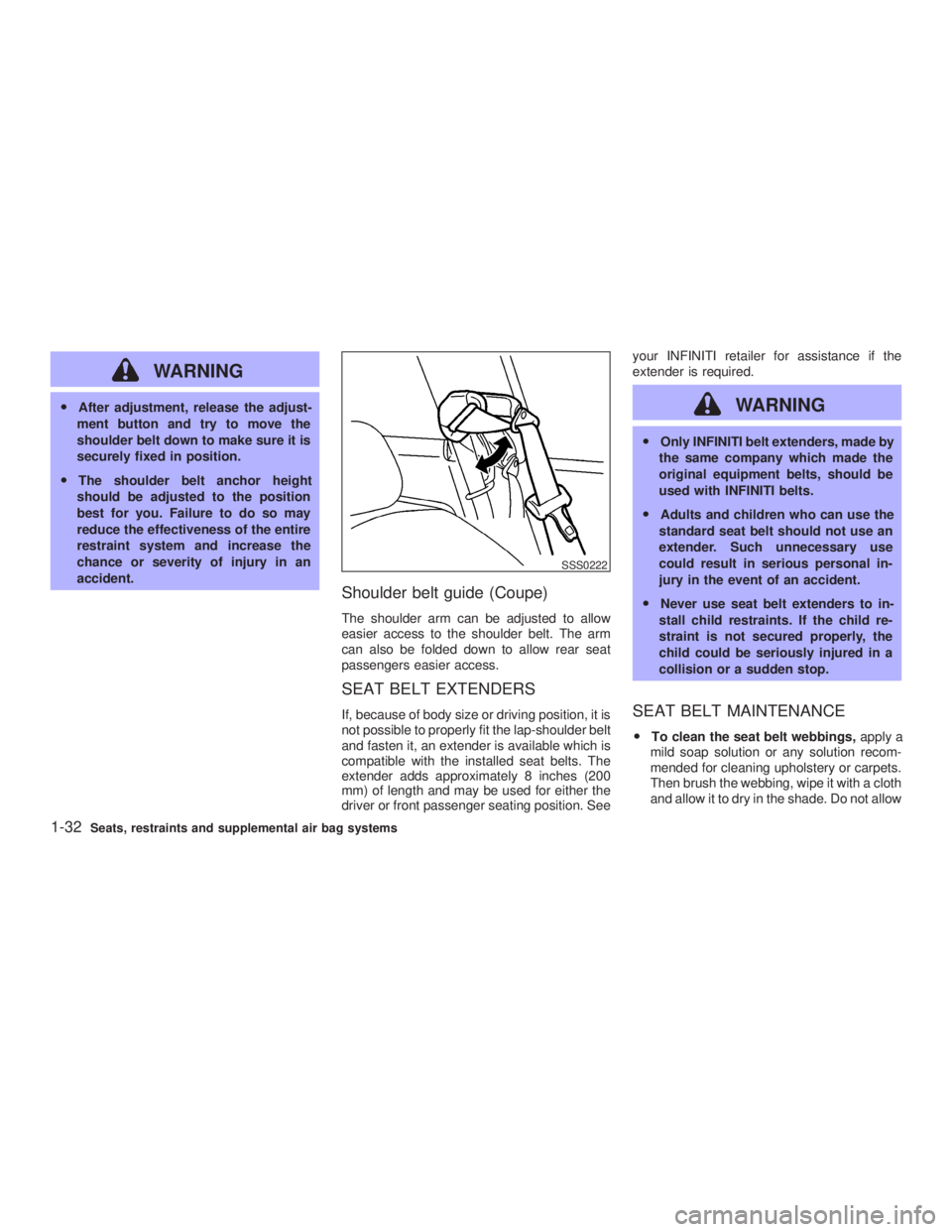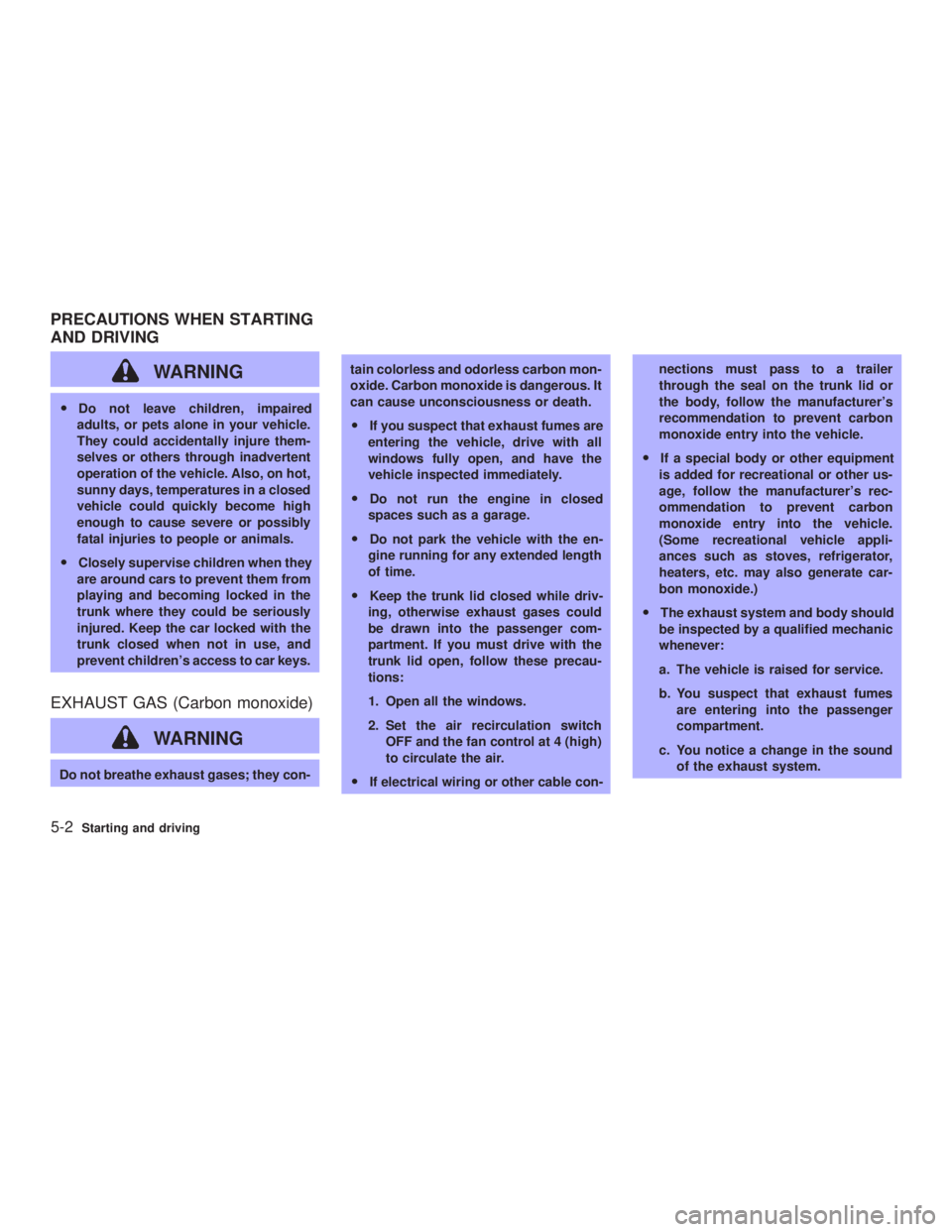2003 INFINITI G35 length
[x] Cancel search: lengthPage 38 of 256

WARNINGO After adjustment, release the adjust-
ment button and try to move the
shoulder belt down to make sure it is
securely fixed in position.
O The shoulder belt anchor height
should be adjusted to the position
best for you. Failure to do so may
reduce the effectiveness of the entire
restraint system and increase the
chance or severity of injury in an
accident.
Shoulder belt guide (Coupe) The shoulder arm can be adjusted to allow
easier access to the shoulder belt. The arm
can also be folded down to allow rear seat
passengers easier access.
SEAT BELT EXTENDERS If, because of body size or driving position, it is
not possible to properly fit the lap-shoulder belt
and fasten it, an extender is available which is
compatible with the installed seat belts. The
extender adds approximately 8 inches (200
mm) of length and may be used for either the
driver or front passenger seating position. See your INFINITI retailer for assistance if the
extender is required.
WARNING O Only INFINITI belt extenders, made by
the same company which made the
original equipment belts, should be
used with INFINITI belts.
O Adults and children who can use the
standard seat belt should not use an
extender. Such unnecessary use
could result in serious personal in-
jury in the event of an accident.
O Never use seat belt extenders to in-
stall child restraints. If the child re-
straint is not secured properly, the
child could be seriously injured in a
collision or a sudden stop.
SEAT BELT MAINTENANCE O To clean the seat belt webbings, apply a
mild soap solution or any solution recom-
mended for cleaning upholstery or carpets.
Then brush the webbing, wipe it with a cloth
and allow it to dry in the shade. Do not allow SSS0222
1-32 Seats, restraints and supplemental air bag systems
Z 02.7.29/V35-D/V5.0
X
Page 124 of 256

power lines, electric signs and even traffic
lights.
SATELLITE RADIO RECEPTION When the satellite radio is first installed or the
battery has been replaced, the satellite radio
may not work properly. This is not a malfunc-
tion. Wait more than 10 minutes with satellite
radio ON for satellite radio to receive all of the
necessary data.
AUDIO OPERATION
PRECAUTIONS
Cassette player O To maintain good quality sound,
INFINITI recommends using cassette
tapes of 60 minutes or shorter in length.
O Cassette tapes should be removed from
the player when not in use. Store cas-
settes in their protective cases and away
from direct sunlight, heat, dust, mois-
ture and magnetic sources.
O Direct sunlight can cause the cassette to
become deformed. The use of deformed
cassettes may cause the cassette to jam
in the player.
O Do not use cassettes with labels which
are peeling and loose. If used, the label could jam in the player.
O If a cassette has loose tape, insert a
pencil through one of the cassette hubs
and rewind the tape firmly around the
hubs. Loose tape may cause tape jam-
ming and wavering sound quality.
O Over a period of time, the playback
head, capstan and pinch roller may col-
lect a tape coating residue as the tape is
played. This residue accumulation can
cause weak or wavering sound, and
should be removed periodically with a
head cleaning tape. If the residue is not
removed periodically, the player may
need to be disassembled for cleaning.
Compact Disc (CD) player O During cold weather or rainy days, the
player may malfunction due to the hu-
midity. If this occurs, remove the CD and
dehumidify or ventilate the player com-
pletely.
O The player may skip while driving on
rough roads.
O The CD player sometimes cannot func-
tion when the compartment temperature
is extremely high. Decrease the tem-
perature before use. O Only use high quality 4.7 inches (12 cm)
round discs that have the ªCOMPACT
disc DIGITAL AUDIOº logo on the disc
or packaging.
O Do not expose the CD to direct sunlight. SAA0480
4-8 Heater, air conditioner and audio systems
Z 02.7.29/V35-D/V5.0
X
Page 136 of 256

WARNINGO Do not leave children, impaired
adults, or pets alone in your vehicle.
They could accidentally injure them-
selves or others through inadvertent
operation of the vehicle. Also, on hot,
sunny days, temperatures in a closed
vehicle could quickly become high
enough to cause severe or possibly
fatal injuries to people or animals.
O Closely supervise children when they
are around cars to prevent them from
playing and becoming locked in the
trunk where they could be seriously
injured. Keep the car locked with the
trunk closed when not in use, and
prevent children's access to car keys.
EXHAUST GAS (Carbon monoxide)
WARNINGDo not breathe exhaust gases; they con- tain colorless and odorless carbon mon-
oxide. Carbon monoxide is dangerous. It
can cause unconsciousness or death.
O If you suspect that exhaust fumes are
entering the vehicle, drive with all
windows fully open, and have the
vehicle inspected immediately.
O Do not run the engine in closed
spaces such as a garage.
O Do not park the vehicle with the en-
gine running for any extended length
of time.
O Keep the trunk lid closed while driv-
ing, otherwise exhaust gases could
be drawn into the passenger com-
partment. If you must drive with the
trunk lid open, follow these precau-
tions:
1. Open all the windows.
2. Set the air recirculation switch
OFF and the fan control at 4 (high)
to circulate the air.
O If electrical wiring or other cable con- nections must pass to a trailer
through the seal on the trunk lid or
the body, follow the manufacturer's
recommendation to prevent carbon
monoxide entry into the vehicle.
O If a special body or other equipment
is added for recreational or other us-
age, follow the manufacturer's rec-
ommendation to prevent carbon
monoxide entry into the vehicle.
(Some recreational vehicle appli-
ances such as stoves, refrigerator,
heaters, etc. may also generate car-
bon monoxide.)
O The exhaust system and body should
be inspected by a qualified mechanic
whenever:
a. The vehicle is raised for service.
b. You suspect that exhaust fumes
are entering into the passenger
compartment.
c. You notice a change in the sound
of the exhaust system.PRECAUTIONS WHEN STARTING
AND DRIVING
5-2 Starting and driving
Z 02.7.29/V35-D/V5.0
X
Page 230 of 256

WHEELS AND TIRES
Sedan Road wheel Type Size Offset in (mm)
Aluminum 16 x 6-1/2JJ 1.57 (40)
17 x 7JJ 1.75 (45)
Tire Conventional P205/65R16 94V
P215/55R17 93V/W
Spare T145/90D16
Conventional*
*: For option
Coupe Road wheel Type Position Size Offset in (mm)
Aluminum Front 17 x 7-1/2JJ 1.18 (30)
18 x 8JJ 1.18 (30)
Rear 17 x 8JJ 1.30 (33)
18 x 8JJ 1.18 (30)
Tire Conventional Front P225/50R17 93V
P225/45R18 91W
Rear P235/50R17 95V
P245/45R18 96W
Spare T145/90D16
T155/80R17*
Conventional*
*: For option DIMENSIONS AND WEIGHTS Sedan Coupe
Overall length in (mm) 186.5 (4,736) 182.2 (4,628)
Overall width in (mm) 69.0 (1,753) 71.5 (1,815)
Overall height in (mm) 57.7 (1,467) 54.8 (1,393)
Front tread in (mm) 59.4 (1,510)*1
59.1 (1,500)*2 60.4 (1,535)
Rear tread in (mm) 59.6 (1,515)*1
59.3 (1,505)*2 60.6 (1,540)*3
60.8 (1,545)*4
Wheelbase in (mm) 112.2 (2,850) Ã
Gross vehicle weight rating lb (kg)
See the F.M.V.S.S. certification
label on the driver's side lock
pillar.Gross axle weight rating
Front lb (kg)
Rear lb (kg)
*1: For models with road wheel size Ð 16 x 6.5JJ [offset 1.57 in (40 mm)]
*2: For models with road wheel size Ð 17 x 7JJ [offset 1.75 in (45 mm)]
*3: For models with road wheel size Ð 17 x 8JJ [offset 1.30 in (33 mm)]
*4: For models with road wheel size Ð 18 x 8JJ [offset 1.18 in (30 mm)]
10-8 Technical and consumer information
Z 02.7.29/V35-D/V5.0
X
Page 240 of 256

condition; check for improper tongue load,
overload, worn suspension or other pos-
sible causes of either condition.
O Always secure items in the trailer to prevent
load shifts while driving.
O Be certain your rear view mirrors conform to
all federal, state or local regulations. If not,
install any mirrors required for towing be-
fore driving the vehicle.
Trailer towing tips In order to gain skill and an understanding of
the vehicle's behavior, you should practice
turning, stopping and backing up in an area
which is free from traffic. Steering stability, and
braking performance will be somewhat differ-
ent than under normal driving conditions.
O Always secure items in the trailer to prevent
load shift while driving.
O Avoid abrupt starts, acceleration or stops.
O Avoid sharp turns or lane changes.
O Always drive your vehicle at a moderate
speed.
O Always block the wheels on both vehicle
and trailer when parking. Parking on a
slope is not recommended; however, if you
must do so, and if your vehicle is equipped with automatic transmission, first apply the
parking brake and block the wheels, and
then move the transmission selector lever
into the P (Park) position. If you move the
selector lever to the P (Park) position be-
fore blocking the wheels and applying the
parking brake, the transmission may be
damaged.
O When going down a hill, shift into a lower
gear and use the engine braking effect.
When ascending on a long grade, down-
shift the transmission to a lower gear and
reduce speed to reduce chances of engine
overloading and/or overheating.
O If the engine coolant rises to an extremely
high temperature when the air conditioning
system is on, turn off the air conditioner.
Coolant heat can be additionally vented by
opening the windows, switching the fan
control to high and setting the temperature
control to the HOT position.
O Trailer towing consumes more fuel than
normal circumstances.
O Avoid towing a trailer for the first 500 miles
(800 km).
O Have your vehicle serviced more often than
at intervals specified in the recommended
maintenance schedule. O When making a turn, your trailer wheels will
be closer to the inside of the turn than your
vehicle wheels. To compensate for this,
make a larger than normal turning radius
during the turn.
O Crosswinds and rough roads will adversely
affect vehicle/trailer handling, possibly
causing vehicle sway. When being passed
by larger vehicles, be prepared for possible
changes in crosswinds that could affect
vehicle handling. If swaying does occur,
firmly grip the steering wheel, steer straight
ahead, and immediately (but gradually) re-
duce vehicle speed. This combination will
help stabilize the vehicle. Never increase
speed.
O Be careful when passing other vehicles.
Passing while towing a trailer requires con-
siderably more distance than normal pass-
ing. Remember the length of the trailer
must also pass the other vehicle before you
can safely change lanes.
O To maintain engine braking efficiency and
electrical charging performance, do not use
sixth gear (manual transmission) or fifth
position (automatic transmission).
O Avoid holding the brake pedal down too
long or too frequently such as on long
down-hill sections of road. This could cause
10-18 Technical and consumer information
Z 02.7.29/V35-D/V5.0
X